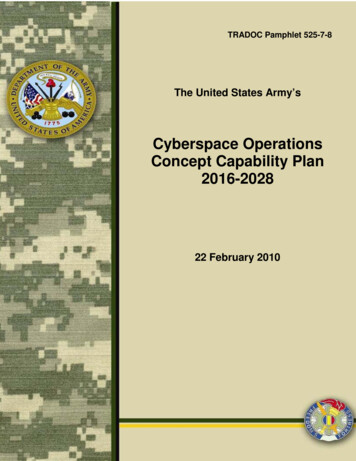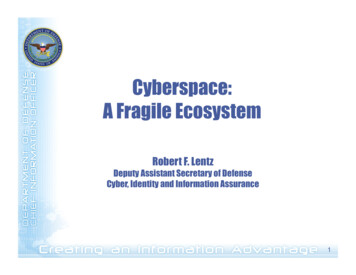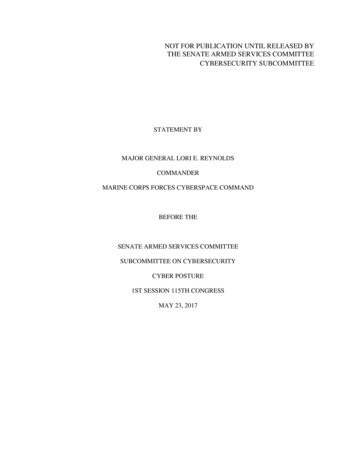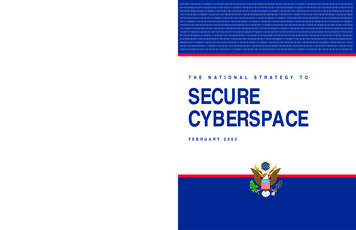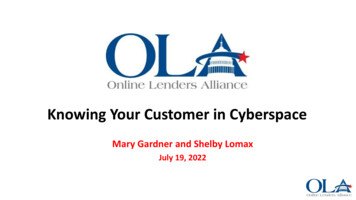
Transcription
Knowing Your Customer in CyberspaceMary Gardner and Shelby LomaxJuly 19, 2022
History of Know Your Customer (KYC) Bank Secrecy Act (1970) – Established first comprehensive anti-moneylaundering recordkeeping and reporting requirements banks and otherfinancial institutions that form the foundations of KYC requirements.Subsequent legislation: Expanded the applicability of these requirements beyond just banks and financialinstitutions. Added additional transaction reporting requirements and new registrationrequirements for non-bank businesses. Expanded information sharing and enforcement powers of overseeing agencies Increased penalties for violations. USA PATRIOT Act (2001) – Vastly expanded the scope of what wasconsidered “money laundering”, increased private sector’s burdens forpreventing money laundering, and increased penalties for noncompliance.Source: nglaws#: :text mbat%20money%20laundering.
Importance of KYC RequirementsKYC requirements can be viewed as pain points in the customer relationshipmanagement process, but they can also be viewed as risk mitigators from anoperational standpoint: Customer Verification – KYC requirements help financial businesses reduce risk byensuring that customers are who they say they are. Due Diligence – KYC requires financial businesses to examine potential customers’risk factors prior to providing services to them Regulatory & Legal – Financial institutions are legally obliged perform KYC checks,but performing KYC checks can help other financial businesses avoid facilitating:o Identity Theft,o Money Laundering & Terrorist Financing, ando Other Financial Fraud*Financial institutions can push KYC requirements onto non-bank partners*
Customer Identification Program (CIP)101
Minimum Requirements tionRecordkeepingand omeragainstgovernmentlists
Minimum Requirements: Notification andCollection of InformationCustomer Notification Must inform customer of identification requirements before account opening May be oral or written May be posted on the website or on the account applicationRequired Information Name DOB Address Identification Number
Minimum Requirements: Customer VerificationProcessTiming “within a reasonable time after the account is opened.”Customer Identity Verification Documentary Methods Individuals - Unexpired government-issued ID Businesses – Entity formation documents, business license, etc. Non-Documentary Methods Contacting customer Verification through comparison of information provided and credit report or other sources Checking bank or other financial institution referencesAdditional Verification Requirements Business Accounts and individual authorities
Minimum Requirements: Lack of VerificationProcedures must include response toinability to verify the true identity of thecustomer. This includes detailing: When not to open the account When to allow account use untilverification is attained When to close an account When to file a SAR
Minimum Requirements: OFAC Screenings
Minimum Requirements: Recordkeeping andRetentionRecords Required: All identifying customer information obtainedDescription of documents relied onDescription of methods/results of verificationDescription of discrepancy resolutionRetention Requirements: 5 years after date account is closed Must be original documentation used to open the account
Consequences of Customer Identification Failures
Fraud in Online Loan Applications Business loan application fraud Fictitious or non-existent businesses may obtain loans intended for illicit purposes or thatthey never intend to repay Look for online reviews Review social media for the company Take steps to identify beneficial owners of companies Synthetic identity fraud A real identity (usually a child or elderly person) that is modified to create a wholly newidentity. Red flags: New phone numberNew credit report/thin credit fileFraud farm behaviorTimezone mismatch between network data and device data
Common Consequences of CustomerIdentification Failures Failure to accurately identify applicants’ identities leads to: Increased operational costsNegative impact on consumers whose identity was stolenDirect Monetary Loss to the lenderStrain on IT capabilityLost customersRisk of regulatory scrutiny
The FTC’s Toolkit to Pursue PurportedConsumer Fraud Section 5 Unfairness Claims: Section 5(a) of the FTC Act provides that “unfair ordeceptive acts or practices in or affecting commerce . . . are . . . declared unlawful.”15 U.S.C. § 45(a)(1). “Unfair” Element: When an act or practice “causes or is likely to cause substantial injuryto consumers which is not reasonably avoidable by consumers themselves and notoutweighed by countervailing benefits to consumers or to competition.” 15 U.S.C. §45(n). Telemarketing Sales Rule (TSR), 16 C.F.R. Part 310: Assisting and Facilitating: When a person substantially assists or supports aseller/telemarketer and “knows or consciously avoids knowing” that theseller/telemarketer engages in an act or practice that violates the TSR. Note: The CFPB has authority to enforce the Telemarketing Act and TSR too.
The CFPB’s Toolkit to Pursue PurportedConsumer Fraud Unfairness Claims: Section 1031(c)(1) of the Consumer Financial Protection Act (CFPA) When there is a “reasonable basis” that an act or practice: (1) causes or is likely to cause consumerssubstantial injury; (2) that is not reasonably avoidable by them; and (3) “such substantial injury is notoutweighed by countervailing benefits to consumers or to competition.” 12 U.S.C. § 1031(c)(1). Strikingly similar to the FTC Act’s standard Fair Credit Reporting: The Fair Credit Reporting Act (FCRA) and its implementing regulations,Regulation V (12 C.F.R. pt 1022) Furnishers of information to consumer reporting agencies must establish and implement written policies andprocedures for ensuring the accuracy and integrity of furnished information regarding consumers. 12 C.F.R. §1022.42(a). This includes ensuring that information furnished pertains to the appropriate customer. Lenders should be able to “[p]rovide consumer reporting agencies with sufficient identifying information inthe [lender’s] possession about each consumer about whom information is furnished ot enable theconsumer reporting agency properly to identify the customer.” 12 CFR Appendix E to Part 1022 III.(k).
The CFPB’s Toolkit to Pursue PurportedConsumer Fraud Non-bank Supervision & Examination – The CFPB has the power to assertsupervisory authority over non-bank consumer financial services companiesit has “reasonable cause to determine . . . [are] engaging, or [have]engaged, conduct that poses a risk to consumers.” 12 U.S.C. 5514(a)(1)(C).o Once a non-bank is subject to the CFPB’s supervisory authority, it may become thesubject of a supervisory exam, which can be a grueling process.o The CFPB has not exercised this authority since the passing of the Dodd-Frank Act,but Director Rohit Chopra recently signaled the Bureau’s intention to start invokingit.
FinCEN: Civil and Criminal LiabilityCIVIL LIABILITY Recordkeeping Violations: Maximum penalty of 23,011 (assessed after1.24.22) General Penalty for BSA Violations: Between 62,689 - 250,759 (assessed after1.24.22) Personal Liability may be imposed onemployees/officers Haider CaseCRIMINAL LIABILITY Recordkeeping Violations: 1,000 fine, imprisoned for 1 year, or both 10,000 fine, imprisoned for 5 years, or both Currency and Foreign Transactions ReportingAct Violations: 250,000 fine, imprisoned for 5 years, or both 500,000 fine, imprisoned for 10 years, or both False Statements/Representations: 10,000 fine, imprisoned for 5 years, or both
Increasing Efficiencies in the CustomerIdentification Process
Increasing Efficiencies: Third-Party VerificationServicesBenefits: Decrease costs Business can focus on developing and implementing profitable lending strategiesRisks: Third-party vendors may not be in full compliance with KYC/CIP requirements Third-party vendors may not adequately updated technology as requirementschange Lenders may not be able to pass on liability to the third-party vendorsLender Requirements: monitor and review third-party compliance Identify red flags with third-party vendors
Changes on the HorizonSource: egime
Questions/DiscussionIf you would like to ask a question, you can ASK or typeyour question into the CHAT feature NOW.
Feel free to contact us for further information:Mary M. GardnerPartnerVenable LLP(202) 344-4398MMGardner@Venable.comShelby D. LomaxAssociateBradley Arant Boult Cummings(615) 516-3546slomax@bradley.com
Customer Identification Program (CIP) 101. Minimum Requirements Overview. CIP. Collect Customer Information. Verify Customer Identification. Screen Customer against government lists. Recordkeeping and Retention. Customer Notification. Customer Notification Must inform customer of identification requirements before account opening May be .
